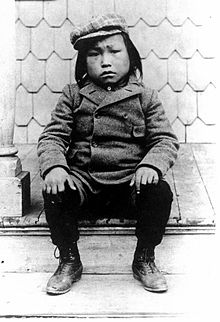Minik Wallace
Minik Wallace (also called Mene ; about 1890 – 29 October 1918) was an Inuit from Greenland. He was brought to New York City as a child in 1897, by the explorer Robert Peary. His father and four others were also brought. The six of them were studied by staff at the American Museum of Natural History, which was given custody of them. Most of them died soon after arriving.
Minik Wallace | |
|---|---|
 Minik in New York shortly after his arrival, 1897. | |
| Born | about 1890 |
| Died | 29 October 1918 (aged 28) Pittsburg, New Hampshire, United States |
Minik was a member of the Inughuit, the northernmost group of Inuit in Greenland. His father was named Qisuk. They met Peary when the explorer employed men from the Inughuit during several expeditions into the Arctic. Peary asked some of them to come with him to New York. Six of them agreed, including Qisuk and Minik. Peary did not tell them about the real purpose of the trip. Some agreed to travel to see new places; others did not want to be separated from relatives.[1] Peary promised them that they would be able to return to Greenland. Soon after their arrival, the group became the objects of study. The museum staff had not made plans for their care, nor for their return.[2]
Soon after arriving in New York, most of the Inuit contracted the disease tuberculosis. Three adults and one child died, including Minik's father. A fourth adult survived and was returned to Greenland. Minik was the only one left. William Wallace, the curator of the museum, adopted Minik. Minik pleaded for a proper Inuit burial for his father. The museum staff wanted to preserve Qisuk's body for study. They made a fake body and put it in a coffin. They staged a fake burial so that Minik would think he was burying his father.[2][3]
The museum put the skeleton on display. In about 1906, a story was published in local newspapers that stated Qisuk's skeleton was displayed in the museum. Minik was told about it by his classmates at school.[2] He then asked that his father's bones be given to him for traditional burial. Wallace supported Minik in this, but the museum denied that they had the body. Minik was never able to reclaim his father's bones.
Minik returned to Greenland in 1910, with the help of Peary. He came back to the United States in 1916. He lived and worked there until dying of influenza in the pandemic of 1918.[3]
Kenn Harper wrote a book about Minik in 1986. The book was called Give Me My Father's Body. Harper spent several years trying to persuade the Museum of Natural History to return the remains of the four Inuit to Greenland. He succeeded in 1993. The bodies were buried in a funeral in Qaanaaq. Minik is buried in a cemetery in Pittsburg, New Hampshire.[3]
References
change- ↑ Russell A. Potter. "Review: Give Me My Father's Body: The Story of Minik, the New York Eskimo". Rhode Island College. Archived from the original on 20 August 2016. Retrieved 6 February 2016.
- ↑ 2.0 2.1 2.2 Kenn Harper (2001). Give Me My Father's Body: The Life of Minik, the New York Eskimo. New York: Washington Square Press. ISBN 9780743410052.
- ↑ 3.0 3.1 3.2 Axel Engstfeld (2008). "Minik The Lost Eskimo". The American Experience. PBS. Archived from the original on 2016-12-27https://www.pbs.org/wgbh/amex/minik/program/pt.html. Retrieved 2017-08-31.
{{cite episode}}:|transcript-url=missing title (help)
Other websites
change- Media related to Minik Wallace at Wikimedia Commons
- Minik Wallace Archived 2013-03-09 at the Wayback Machine at the Memory Palace podcast